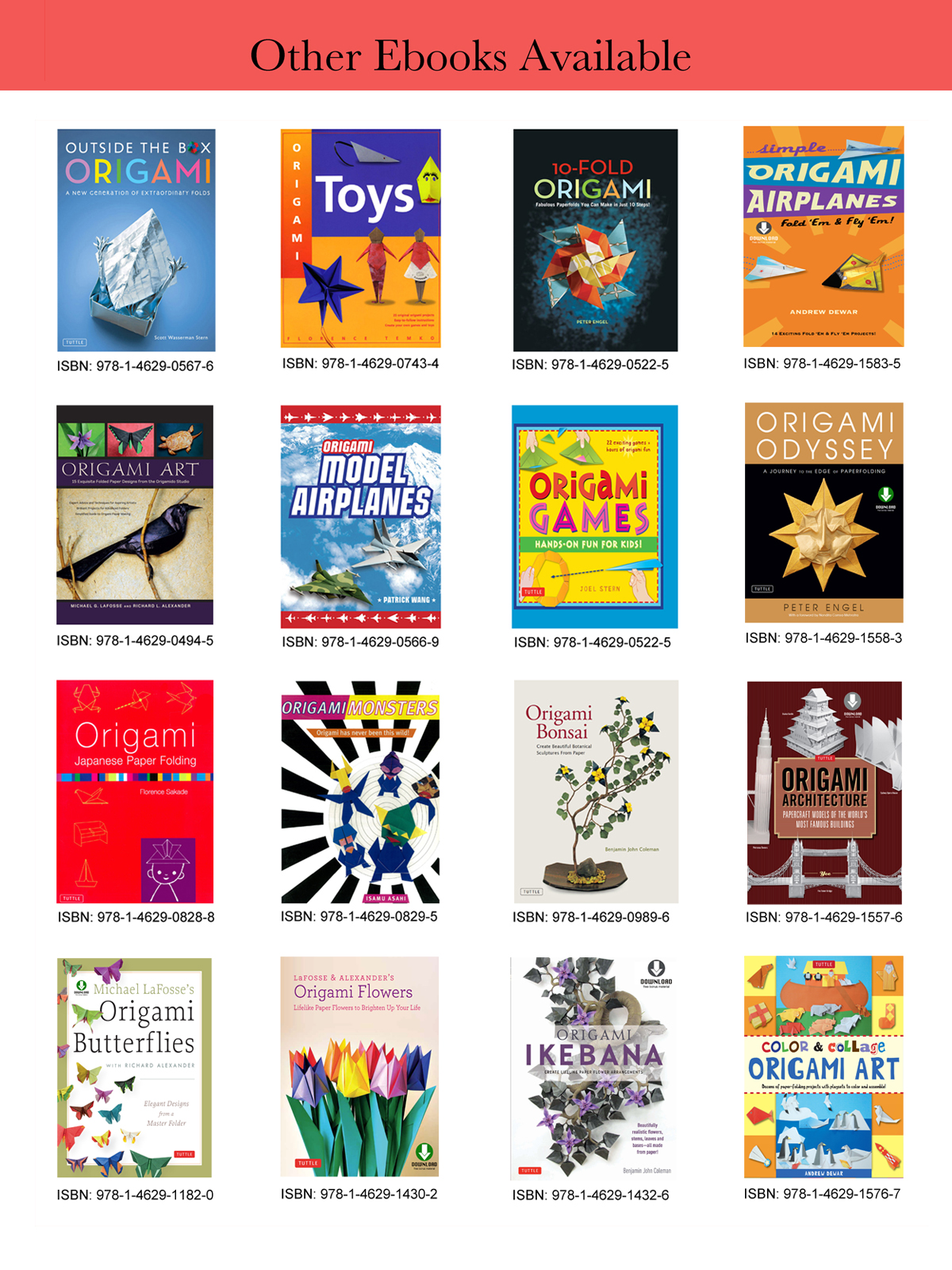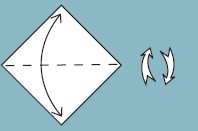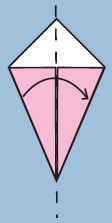Tuttle Editors - Amazing Origami Kit: Traditional Japanese Folding Papers and Projects
Here you can read online Tuttle Editors - Amazing Origami Kit: Traditional Japanese Folding Papers and Projects full text of the book (entire story) in english for free. Download pdf and epub, get meaning, cover and reviews about this ebook. year: 2012, publisher: Tuttle Publishing, genre: Children. Description of the work, (preface) as well as reviews are available. Best literature library LitArk.com created for fans of good reading and offers a wide selection of genres:
Romance novel
Science fiction
Adventure
Detective
Science
History
Home and family
Prose
Art
Politics
Computer
Non-fiction
Religion
Business
Children
Humor
Choose a favorite category and find really read worthwhile books. Enjoy immersion in the world of imagination, feel the emotions of the characters or learn something new for yourself, make an fascinating discovery.
- Book:Amazing Origami Kit: Traditional Japanese Folding Papers and Projects
- Author:
- Publisher:Tuttle Publishing
- Genre:
- Year:2012
- Rating:4 / 5
- Favourites:Add to favourites
- Your mark:
Amazing Origami Kit: Traditional Japanese Folding Papers and Projects: summary, description and annotation
We offer to read an annotation, description, summary or preface (depends on what the author of the book "Amazing Origami Kit: Traditional Japanese Folding Papers and Projects" wrote himself). If you haven't found the necessary information about the book — write in the comments, we will try to find it.
Origami paper with stunning Japanese traditional prints and fun and simple folding instructions!
Amazing Origami Kit is designed for origami paper folders of all ages and all skill levelsfrom novices up to more experienced folders. It provides everything you need to create exciting and original origami art. The gorgeous folding papers feature delicate patterns with gold detailing, recalling the one-of-a-kind traditional designs used in the Japanese kimono fabrics from a bygone era.
This origami kit contains:
- A full-colored 64-page booklet
- Clear step-by-step instruction and diagrams
- 17 fun-to-do projects
- 144 high-quality origami folding sheets
- 2-sided, full-color folding paper
- 13 custom paper designs
- 6 3/4 X 6 3/4 size paper
The sturdy box doubles as a display pedestal.
One of the pleasing aspects of origami is its simplicity. The paper folder needs nothing more than something to foldno glue, no tape, no string or wirejust a piece of paper! Though the materials are simple, origami exemplifies the ability of the human mind to solve problems and create a beautiful harmony. Origami is relaxing and peaceful, but it is also fun and exciting to discover new ways to fold paper. With Amazing Origamis simple instructions, origami beginners will be able to get started immediately. With the beautiful, Japanese origami paper, experienced paper folders can create unique origami art.
Origami projects include:
- Luna Moth
- Tortoise
- Carp
- Leaf
- Peacock
- Butterfly
- Koi
- Chinese Pinwheel
- And many much
Tuttle Editors: author's other books
Who wrote Amazing Origami Kit: Traditional Japanese Folding Papers and Projects? Find out the surname, the name of the author of the book and a list of all author's works by series.











![Marcia Joy Miller - Origami for Busy People: 27 Original On-The-Go Projects [Origami Book, 48 Papers, 27 Projects]](/uploads/posts/book/151502/thumbs/marcia-joy-miller-origami-for-busy-people-27.jpg)




 Origami Techniques Recognizing Symbols By making this simple flower bud you will learn how to recognize the following origami diagram symbols: Valley fold
Origami Techniques Recognizing Symbols By making this simple flower bud you will learn how to recognize the following origami diagram symbols: Valley fold 1. Begin with a square piece of paper, plain side up if you are using origami paper. Fold the paper in half, bottom corner to the top corner, and then unfold. Here you see what the valley fold (dashed line) is and what the fold and unfold arrow looks like. Next, notice the rotate symbol next to the diagram.
1. Begin with a square piece of paper, plain side up if you are using origami paper. Fold the paper in half, bottom corner to the top corner, and then unfold. Here you see what the valley fold (dashed line) is and what the fold and unfold arrow looks like. Next, notice the rotate symbol next to the diagram.  2.
2.  3. Fold up the left and right sides.
3. Fold up the left and right sides. 4. Fold the bottom corner to the back. Here you will see the mountain fold indication (a broken dashed line) and the arrow meaning fold behind.
4. Fold the bottom corner to the back. Here you will see the mountain fold indication (a broken dashed line) and the arrow meaning fold behind.  5.
5. 1. Begin with a square of paper, plain side up if you are using origami paper. Fold it in half, corner to corner, and then unfold.
1. Begin with a square of paper, plain side up if you are using origami paper. Fold it in half, corner to corner, and then unfold. 2. Fold the two bottom edges to meet at the crease in the center. For neatness, fold only one side at a time. Leave approximately a one-millimeter gap between the two folded flap edges (to facilitate the fold in step 3), but be sure that the edges of the paper align with the crease exactly before you press the paper flat. This shape is often called the kite base.
2. Fold the two bottom edges to meet at the crease in the center. For neatness, fold only one side at a time. Leave approximately a one-millimeter gap between the two folded flap edges (to facilitate the fold in step 3), but be sure that the edges of the paper align with the crease exactly before you press the paper flat. This shape is often called the kite base. 3. Fold the kite base in half, from left side to right. This is a good way to check for neatness. Do all of the edges match? Are the corners neat?
3. Fold the kite base in half, from left side to right. This is a good way to check for neatness. Do all of the edges match? Are the corners neat?  4. Make several of these and use them to practice inside-reverse folding, as explained in the next section, where you will make an origami duck! How did you do? If your shape is not very good, try to figure out what went wrong.
4. Make several of these and use them to practice inside-reverse folding, as explained in the next section, where you will make an origami duck! How did you do? If your shape is not very good, try to figure out what went wrong. 1. Begin with a kite base folded in half (see the previous section for the folding method). Here you see a typical drawing of an inside-reverse fold instruction. Look at step 4 to see what the paper should look like once it has been inside-reverse folded.
1. Begin with a kite base folded in half (see the previous section for the folding method). Here you see a typical drawing of an inside-reverse fold instruction. Look at step 4 to see what the paper should look like once it has been inside-reverse folded. 2. Begin the fold by opening the kite base from underneath. Now you can easily push the narrow end downward. Notice that only part of the kite base will be valley folded, from the bend in the middle to the end of the point.
2. Begin the fold by opening the kite base from underneath. Now you can easily push the narrow end downward. Notice that only part of the kite base will be valley folded, from the bend in the middle to the end of the point.  3.
3. 4. This is what a completed inside-reverse fold should look like.
4. This is what a completed inside-reverse fold should look like.  5. Try adding two more inside-reverse folds, one at the left end and another at the end of the first point.
5. Try adding two more inside-reverse folds, one at the left end and another at the end of the first point. 6. This is your finished duck! Make many of them to become an expert at inside-reverse folding.
6. This is your finished duck! Make many of them to become an expert at inside-reverse folding.